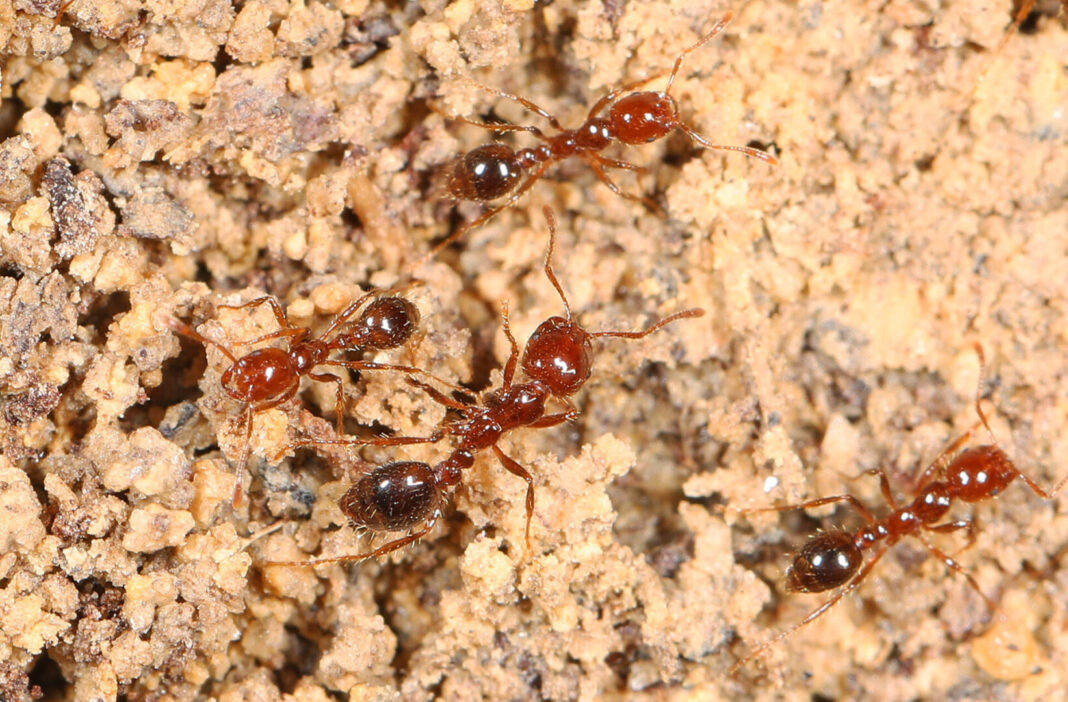Creature Chronicles: The Red Menace
Walking barefoot in the cool, plush grass gives me a feeling of peace. It helps me feel connected to nature. It soothes me. It relieves my stress. That is until I step on fire ants! Yikes! What a sight. Seeing me hoop and holler, jump, run, and slap my feet and legs must be quite a sight, but if you live around here, you know exactly what I’m talking about.
The red imported fire ant first appeared in Mobile, Alabama, in the 1930’s when it was accidentally brought to the USA from South America. They made their way to Texas in 1956. The initial population was eradicated but the ants came back in 1957. From 1957 to 1982, the imported red fire ants moved west at a rate of 20 to 30 miles per year. They have slowed but now cover the eastern two-thirds of the state.
Fire ants normally build and live in mounds but a mound is not necessary for their survival. They may not have a visible mound at all. In extremely hot and/or dry climates, they’ll move deeper into the ground and you won’t see a mound.
Red imported fire ant colonies are made up of several types of adults, or castes. There are winged males, reproductives, workers (wingless, sterile females) and one or more mated queens. The reproductives live in the mound until they make their mating flight. The males die after mating. Fewer than 10% of the females survive and go on to form a colony. The surviving females are now queens and the sperm from mating is stored in their bodies. She will look for a suitable nesting site, shed her wings, and begin digging a chamber to start a new colony.
The queen’s sole purpose is to lay eggs. Fire ant queens can lay both fertilized and unfertilized eggs with the sperm stored in her body since mating. The unfertilized eggs develop into winged males and fertilized eggs will develop into either fertile winged females or sterile female worker ants. Fire ant queens can live up to 7 years and produce up to 1,000 eggs per day. There are single queen colonies called monogyne colonies and multiple queen colonies called polygynes.
Colonies are made up of 100,000 to 500,000 worker ants, and several hundred winged reproductives. The worker ants are responsible for the construction and maintenance of the nest, caring for the brood and queen, foraging for food, protecting the colony, and disposing of the waste. They’re always working! As the workers age, they have fewer responsibilities. Fire ant workers generally live 4 to 6 weeks.
Fire ants are hard to get rid of. Fire ants are tough and resilient and their mounds are very durable. If you’re a homeowner, you know this. The main reason is that they live in huge colonies. If you try to eliminate a colony incorrectly, they’ll divide and start a new colony. Their tunnels go deep into the ground, can extend up to 8 feet in all directions and have multiple entrances and exits. They can even survive floods. Do you remember seeing clumps of floating fire ants during Hurricane Harvey in 2017? These temporary structures had up to 100,000 ants and the ants survived the ride until a permanent home was found. All hope is not lost, however. Here are some things you can try.
- An old school method is to use boiling water. According to Texas A&M, it works about 60% of the time. The problem is that the boiling water will probably not reach the queen who is deep underground.
- Drench the mound with liquid insecticide.
- Try putting bait around the mound. Products like Amdro work well. The worker ants will carry the bait to the others in the mound and will even take it to the queen.
- You can treat a large area using a broadcast spreader.
- Call a professional. They have access to more potent insecticides than what’s sold over the counter.
Now, about that sting. You’ll know it when you get stung! The red fire ant will attach itself to your skin with clamp-like mandibles. It will then use its abdominal stinger to inject its alkaloid venom into the victim. It will sting repeatedly until it’s brushed away or killed. The stings cause a burning sensation. Next comes an itchy welt and then a blister. Oftentimes, the little blisters are filled with a pus-like fluid. This is actually dead tissue. Try not to scratch the sting and don’t try to squeeze out the fluid. It can lead to infection and scarring. To relieve the discomfort, you can ice the area, take an antihistamine and use a hydrocortisone cream to relieve the itching. Although rare, some may experience an allergic reaction to the stings. Seek medical attention if you get hives, cramping in your gut with nausea and diarrhea, dizziness, tightening in your chest or swelling of the tongue.
Is there anything good to be said about red fire ants? They can reduce tick, chigger, flea larvae and hatching cockroach populations. That’s about it.
My only advice—watch your step because they’re here to stay.















